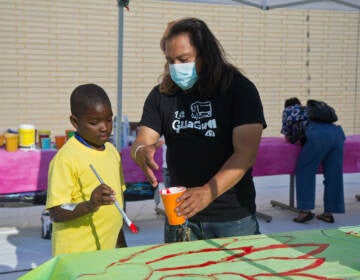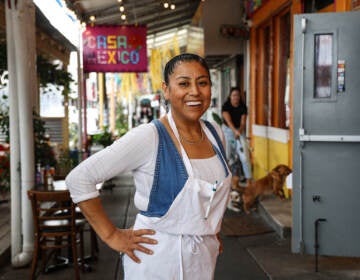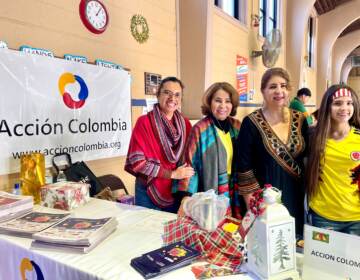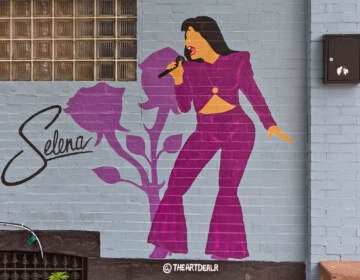‘La Guagua 47’ is a love letter to Philly’s Latino community
Alba Martínez’s film had help from more than 100 community members and artists throughout Philly. The short film is set to debut at the Kimmel Center.
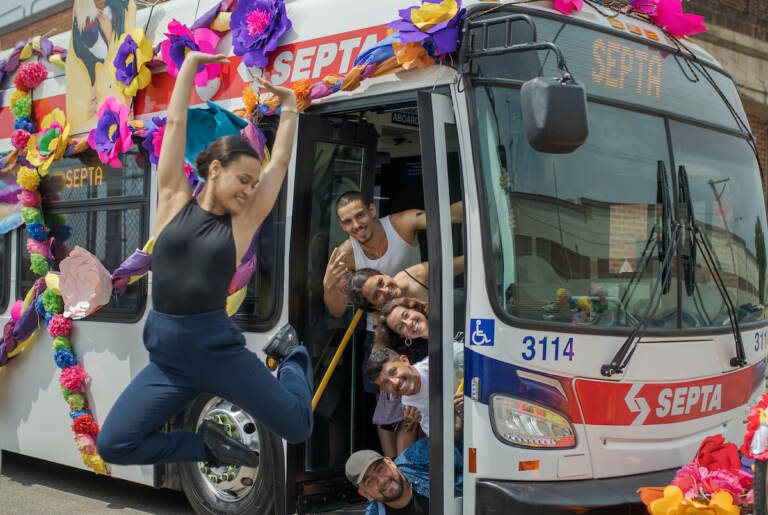
Dancer Ashley Rivera, who is the protagonist in the film, strikes a pose mid-air. Inside the bus, from top to bottom are the production team: Alaitz Ruiz, Christina Castro-Tauser, Alba Martinez, Martin Alfaro and director, Pedro Escárcega. (Courtesy of Ritmo Lab)
Inspired by her own life-changing journey on SEPTA’s 47 bus, Alba Martínez’s short film, “La Guagua 47,” showcases the magic and joy found in Philadelphia’s vibrant Latino community.
Martínez believes that “when we come together, our culture is richer,” and hopes the film will promote the visibility of Latinos within the city.
“What I see is this beauty and magic and this vast talent in the community, which I don’t think other people see or have access to,” Martínez said. “I want to showcase the Latino community I see and wanted to do it in a way that was as inclusive of as many people as possible.”
The short film is set to debut at the Kimmel Center on Thursday, Sept. 15 — the first day of Hispanic Heritage Month. It follows a young Latina migrant who is new to Philly and discovers community as she takes SEPTA’s 47 bus route through the city.
While the film is inspired by Martínez’s personal story, she hopes the universal experience of finding community resonates with a large audience. Martínez, who is Puerto Rican, sought talent from all over the city and the Latin diaspora to represent the diversity of Latinidad in Philadelphia.
The premiere event kicks off at 5 p.m. and features a networking hour, followed by a panel discussion at the Perelman Theater and a dance party to wrap it all up.
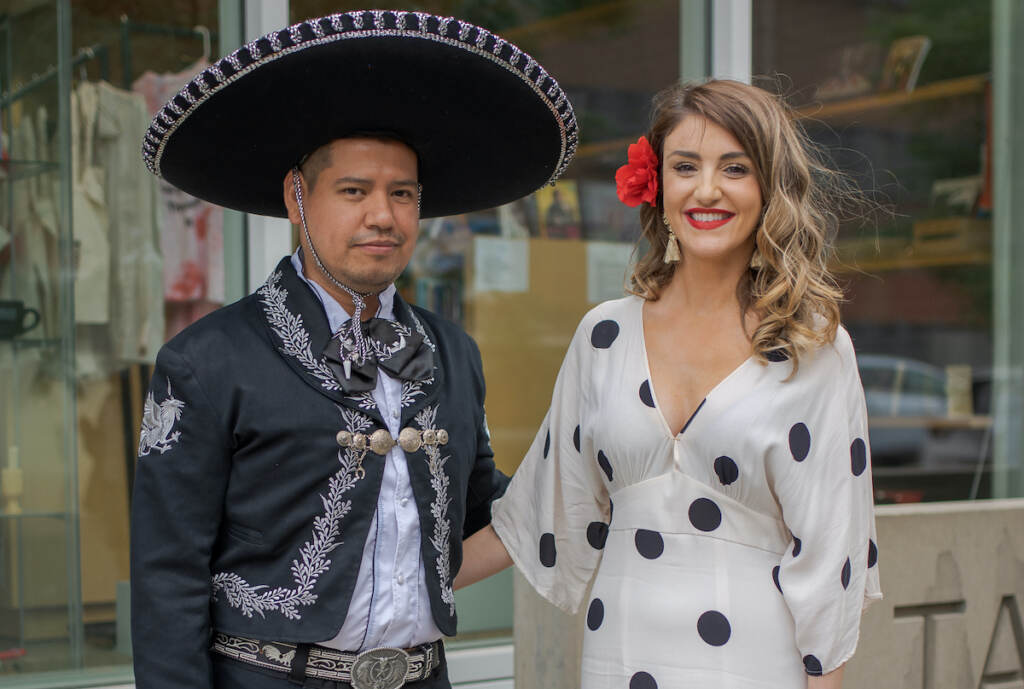
A vehicle for visibility
Martínez hopes this project encourages the city to give Latino creatives more opportunities and visibility.
“I want it to be a vehicle for the Latino community of Philadelphia to shine bright and to be seen,” she added. “The Latino community belongs to the city of Philadelphia, so if the community thrives, the city thrives.”
The project began in March, when “La Guagua 47” collaborated with SEPTA and Al Día for their Aborrdo SEPTA program, a series of stories about finding community using public transportation. Martínez’s story was the first in the series, and out of that blossomed a partnership. Later, SEPTA offered a driver for the film, Emilio Tapia, who usually drives the 47 bus route. For the film, he drove a bus which was decorated by the community for the film.
César Viveros, a muralist and the project’s lead visual artist, has always used his art to share his Mexican heritage. “La Guagua 47” reignited his passion to use art as a way to engage the community on social issues and to remind members of the Latino community to use their voices to tell their own stories.
“This is an example of pure collaboration between artists, dancers, writers, and the community, coming together to try and show the city more than what people know,” he said. “We are retaking our story and retelling it in our own terms and our own language, to tell the world who we are.”
The project exemplifies the important role public transportation plays regarding access and opportunities, said Elvira Mendez Crespo, SEPTA’s public information manager and spokesperson.
“I was there when they were filming and seeing the energy, the passion, and seeing so many different nationalities working together, it was just beautiful,” said Mendez Crespo, who’s from Spain and happens to be SEPTA’s only Spanish-speaking spokesperson. “I’m getting goosebumps right now. I can’t wait to see the premiere.”
With more than 100 artists, volunteers, and community members, the project is “far beyond her project,” said Martínez — it belongs to the community.
“It’s a love letter to the Latino community, but it’s also a business card where we’re saying we’re here, we have a lot that’s happening here, and we want people to take part in it,” she added.
‘Something to be proud of’
The project pulls from various Latino nationalities and identities throughout Philadelphia and surrounding cities.
Director Pedro Escárcega invited Adayesla Reyes, of Delaware, to act as one of the film’s makeup artists. She was also featured personifying the Statue of Liberty.
For her costume, Reyes made a headpiece out of corn husks and decorated the famous torch with coins emblemed with Xochipili, the Mesoamerican god of dance. She adorned a cape with outlines of the different continents and used symbols from each region, like corn or lentils.
“I wanted to focus on how representative the idea of the Statue of Liberty is to the United States, but also highlight how the blending of cultures in this country is what makes it richer,” Reyes said in Spanish. “I wanted everything to have meaning.”
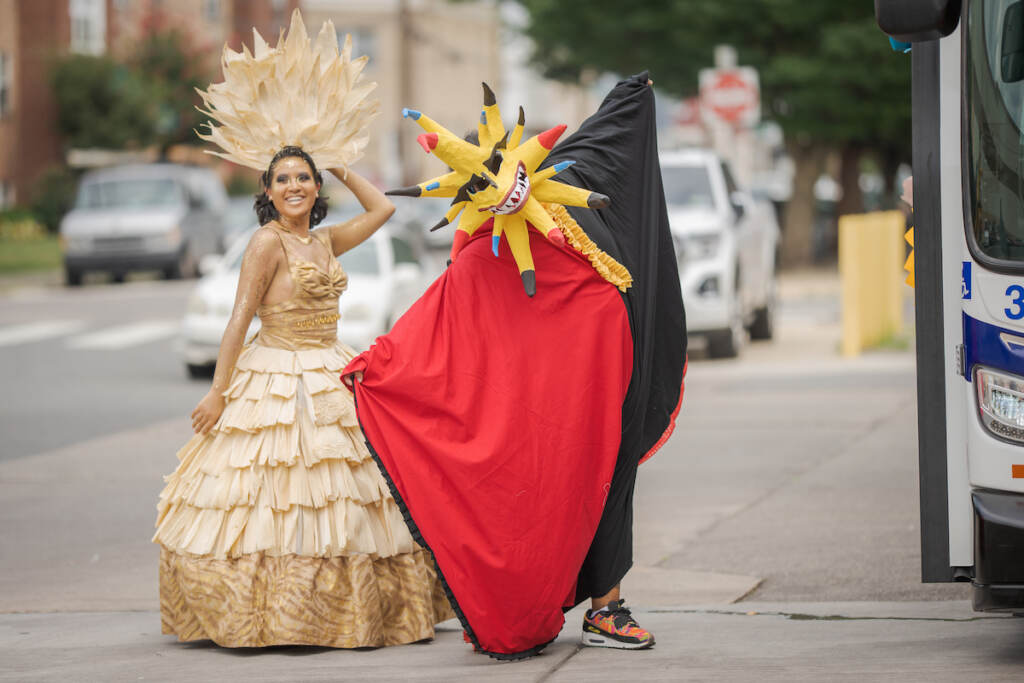
Since starting her makeup career in 2019, Reyes has sought to represent her Latinidad. Her artist name, Dayesla Ixtli, pays homage to her indigenous heritage — Ixtli means face in Nahuat. Nahuatl is an Uzo-Aztecan language spoken by about 1.5 million people in El Salvador and central Mexico in states like Puebla, Veracruz, Oaxaca, and Mexico state, where Reyes is from.
She feels proud to be part of “La Guagua 47” and represent her culture along with other talented and passionate artists, she said.
“I feel like everything the Guagua brings is to focus on the fact that being Latino is cool, it’s something to be proud of,” Reyes said. The mother of three further explained that she also does this for her kids, “I like that my kids can see that I’m a part of this and can be proud to be Mexican, to be Latinos.”
This is the representation Santi Castro always sought to find for himself.
Growing up in Georgia, Castro was ashamed of his culture and would be scared to tell people he was Mexican. As he grew up, he realized he is not who he is without his Mexican and Cuban heritage.
“It’s important to recognize early that your culture is so important to you and is part of you forever,” the 21-year-old bilingual playwright said. “The more you celebrate that and enjoy it, the more power you have in your voice and the way you move in the world.”
Castro got involved in the project because his mom, Christina Castro Tauser, is its choreographer. Santi Castro, who is a trans visual artist, will be presenting a poem at the film’s screening to talk about the different identities that exist within the Latino community.
As an Indigenous person, Santi Castro feels like most Indigenous art is somber and sad because “the story the world wants to tell is that marginalized communities are suffering,” he said.
“This whole project is just memorializing this joy that is in our community,” Santi Castro added. “Alba is breaking the stigma of what it means to be Latinx and what it means to come from a marginalized community.”
Disclosure: WHYY is a partner of La Guagua 47 Community Film and Arts Project.
WHYY is your source for fact-based, in-depth journalism and information. As a nonprofit organization, we rely on financial support from readers like you. Please give today.


